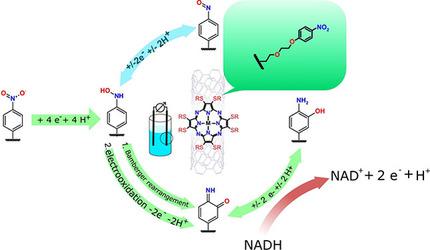当前位置:
X-MOL 学术
›
ChemElectroChem
›
论文详情
Our official English website, www.x-mol.net, welcomes your
feedback! (Note: you will need to create a separate account there.)
Electrocatalytic NADH Sensing using Electrodes Modified with 2‐[2‐(4‐Nitrophenoxy)ethoxy]ethylthio‐Substituted Porphyrazine/Single‐Walled Carbon Nanotube Hybrids
ChemElectroChem ( IF 3.5 ) Pub Date : 2020-06-11 , DOI: 10.1002/celc.202000430 Tomasz Rębiś 1 , Michał Falkowski 2 , Grzegorz Milczarek 1 , Tomasz Goslinski 3
ChemElectroChem ( IF 3.5 ) Pub Date : 2020-06-11 , DOI: 10.1002/celc.202000430 Tomasz Rębiś 1 , Michał Falkowski 2 , Grzegorz Milczarek 1 , Tomasz Goslinski 3
Affiliation

|
The electrochemical properties of a modified electrode covered with 2‐[2‐(4‐nitrophenoxy)ethoxy]ethylthio‐substituted porphyrazine/single‐walled carbon nanotube hybrids were investigated. The electrochemical study revealed that the electrode mechanism is more complex in acidic conditions in comparison to neutral buffer. According to our study, the nitro groups constituting the part of porphyrazine substituents can be electrochemically reduced to the corresponding hydroxylamine moieties; surprisingly, however, the latter can be additionally transformed to o‐aminophenol/o‐iminoquinone groups, but only in acidic conditions. The electrode covered with hybrid material was used in the electrocatalytic oxidation of NADH. According to these results, it seems that after the electrochemical activation of the electrode material, 2‐[2‐(4‐nitrophenoxy)ethoxy]ethylthio‐substituted porphyrazine reveals strong electrocatalytic behavior towards NADH oxidation, owing to the appearance of reversible surface‐anchored o‐aminophenol/o‐iminoquinone intermediate redox couples. In the amperometric determination, the limit of detection (LOD) and limit of quantification (LOQ) of NADH were calculated and found to be LOD=0.16 and LOQ=0.48 μM. Moreover, the relative standard deviation of the response was 3.32 %, indicating excellent reproducibility. Thus, the novel electrode based on 2‐[2‐(4‐nitrophenoxy)ethoxy]ethylthio‐substituted porphyrazine and single‐walled carbon nanotubes present an interesting opportunity in the fields of electroanalytical and biosensing applications, and can be considered for amperometric NADH determination.
中文翻译:

使用2- [2-(4-(4-硝基-硝基苯氧基)乙氧基]乙硫基取代的卟啉/单壁碳纳米管杂化电极修饰的电极进行电催化NADH传感
研究了被2- [2-(4-硝基苯氧基)乙氧基]乙硫基取代的卟啉/单壁碳纳米管杂化物覆盖的修饰电极的电化学性能。电化学研究表明,与中性缓冲液相比,在酸性条件下电极机理更为复杂。根据我们的研究,构成卟啉嗪取代基部分的硝基可被电化学还原为相应的羟胺部分;然而,令人惊讶的是,后者可以另外转化为邻氨基苯酚/邻亚氨基醌基团,但仅在酸性条件下。用杂化材料覆盖的电极用于NADH的电催化氧化。根据这些结果,似乎在电极材料被电化学活化后,2- [2-(4-(4-硝基苯氧基)乙氧基]乙硫基]取代的卟啉由于其表面可逆的锚固作用,显示出对NADH氧化的强电催化性能。Ø氨基苯酚/ Ø亚氨基醌中间体氧化还原对。在安培测定中,计算出NADH的检出限(LOD)和定量限(LOQ),发现其为LOD = 0.16和LOQ =0.48μM。此外,响应的相对标准偏差为3.32%,表明具有出色的重现性。因此,基于2- [2-(4-硝基苯氧基)乙氧基]乙硫基取代的卟啉和单壁碳纳米管的新型电极在电分析和生物传感应用领域中提供了一个有趣的机会,可用于安培NADH测定。
更新日期:2020-07-06
中文翻译:

使用2- [2-(4-(4-硝基-硝基苯氧基)乙氧基]乙硫基取代的卟啉/单壁碳纳米管杂化电极修饰的电极进行电催化NADH传感
研究了被2- [2-(4-硝基苯氧基)乙氧基]乙硫基取代的卟啉/单壁碳纳米管杂化物覆盖的修饰电极的电化学性能。电化学研究表明,与中性缓冲液相比,在酸性条件下电极机理更为复杂。根据我们的研究,构成卟啉嗪取代基部分的硝基可被电化学还原为相应的羟胺部分;然而,令人惊讶的是,后者可以另外转化为邻氨基苯酚/邻亚氨基醌基团,但仅在酸性条件下。用杂化材料覆盖的电极用于NADH的电催化氧化。根据这些结果,似乎在电极材料被电化学活化后,2- [2-(4-(4-硝基苯氧基)乙氧基]乙硫基]取代的卟啉由于其表面可逆的锚固作用,显示出对NADH氧化的强电催化性能。Ø氨基苯酚/ Ø亚氨基醌中间体氧化还原对。在安培测定中,计算出NADH的检出限(LOD)和定量限(LOQ),发现其为LOD = 0.16和LOQ =0.48μM。此外,响应的相对标准偏差为3.32%,表明具有出色的重现性。因此,基于2- [2-(4-硝基苯氧基)乙氧基]乙硫基取代的卟啉和单壁碳纳米管的新型电极在电分析和生物传感应用领域中提供了一个有趣的机会,可用于安培NADH测定。











































 京公网安备 11010802027423号
京公网安备 11010802027423号